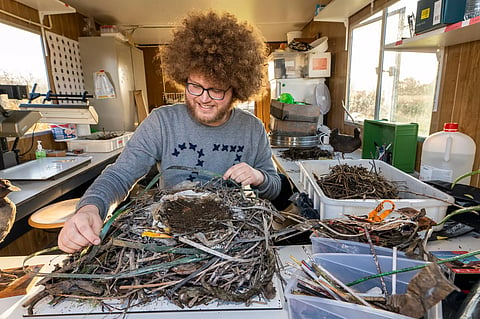

Auke-Florian Hiemstra, a biologist who studies how wild animals re-purpose human materials, thought he had seen everything. In his research on the common coot, a water bird often found in Dutch canals, he had discovered nests containing windshield wipers, sunglasses, plastic carnations, condoms and envelopes used to package cocaine. “So my definition of what is nesting material was already quite a broad one,” said Hiemstra, a doctoral student at the Naturalis Biodiversity Center in the Netherlands. “Almost anything can become part of a bird nest.”
Still, he was not prepared for what he found when he went to investigate a strange nest that had been spotted outside a hospital in Antwerp, Belgium, in July 2021. Nestled near the top of a sugar maple tree was a Eurasian magpie nest that resembled a cyberpunk porcupine, with thin metal rods sticking out in every direction. “I couldn’t believe my eyes,” he recalled. “These are birds making a nest with anti-bird spikes.”
Rows of these sharp metal pins have become a common feature of the urban environment, installed on rooftops and ledges to discourage birds from perching or nesting on buildings. But outside the Antwerp hospital — where, as it happened, many of the rooftop spikes had gone missing — the magpies had managed to convert hostile architecture into a home. “They’re outsmarting us,” Hiemstra said. “We’re trying to get rid of birds, the birds are collecting our metal spikes and actually making more birds in these nests. I think it’s just a brilliant comeback.”
And the Antwerp magpies were not alone. Over the two years that followed, Hiemstra and his colleagues discovered several other nests, built by Eurasian magpies and carrion crows, that contained anti-bird spikes. They described their findings this week in a paper published in the journal Deinsea.
“It’s absolutely fascinating,” said Mark Mainwaring, an expert on bird nests at Bangor University in Wales, who was not involved in the new study. “It shows just how intuitive these birds are, and it shows a certain amount of flexibility to go out and find these new materials and use them.”
Magpies and crows are both members of the corvid family, a group of birds renowned for their intelligence and problem-solving skills. Magpies often build domed nests, assembling thorny branches into roofs designed to protect against predators. In the nests that Hiemstra and his colleagues found, the magpies seemed to use the anti-bird spikes for the same purpose, turning them into a spiky nest cover.
“The Antwerp nest is really like a bunker for birds,” said Hiemstra, who calculated that it contained roughly 50 meters’ worth of anti-bird strips and 1,500 visible spikes. “It must feel really safe sitting in the middle knowing that there are 1,500 metal shards or pins defending you.”
Although the researchers did not catch the magpies in the act of tearing the strips from the hospital roof, spikes had disappeared from the area near the birds’ nest, and other birds have been observed ripping such spikes from buildings. And sharp, human materials, including barbed wire and knitting needles, have previously been found in magpie domes, the scientists noted.
Anthes is a reporter with NYT©2023